- Regulatory Status
- RUO
- Other Names
- APOE, Apo-E, Apolipoprotein E, Apolipoprotein E3, ApoE3
- Ave. Rating
- Submit a Review
- Product Citations
- publications
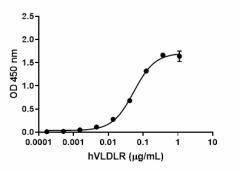
-

When hVLDLR is coated at 1.0 µg/mL (100 μL/well), human Apolipoprotein E3/APOE3 binds with an EC50 of 0.05 – 0.2 µg/mL. HRP anti-His tag antibody (Cat. No. 652504) was used to detect the binding. -

Stability testing for human APOE3. Recombinant human APOE3 was aliquoted in 20 mM Tris, 300 mM NaCl, 1 mM TCEP, pH 7.5 at 0.2 mg/mL. One aliquot was frozen and thawed four times (4x Freeze/Thaw), and compared to a control kept at 4°C (Control). The samples were tested in a binding assay with human VLDLR.
| Cat # | Size | Price | Quantity Check Availability | Save | ||
|---|---|---|---|---|---|---|
| 786802 | 10 µg | 54 CHF | ||||
ApoE is an approximately 34-kD protein that aids in the transport of cholesterol and other lipids in plasma and the central nervous system (CNS). ApoE is comprised of two independently folded N-terminal and C-terminal domains which are joined together by a flexible hinge region. The N-terminal domain contains the ApoE receptor binding region, whereas the lipid binding region is found within the C-terminal domain. ApoE regulates lipid homeostasis by mediating lipid transport from one tissue or cell type to another. More specifically, ApoE regulates the clearance of apolipoproteins from plasma by functioning as the ligand for binding to specific receptors, including the LDL receptor family members and heparan sulfate proteoglycans (HSPGs). In the CNS, ApoE is mainly produced by astrocytes; transporting cholesterol to neurons via ApoE receptors, which are members of the low-density lipoprotein receptor (LDLR) family. ApoE is also produced by macrophages and liver cells, where it mediates cholesterol metabolism in peripheral tissues (in an isoform dependent manner). ApoE has three major isoforms: ApoE2, ApoE3, and ApoE4. Each ApoE isoform has effects on lipid and neuronal homeostasis. ApoE3, the most common of the three isoforms, is considered to be the normal form. ApoE2 and ApoE4 differ from ApoE3 by single amino acid substitutions at positions 112 or 158, respectively. The residues that distinguish the ApoE isoforms are located in the N-terminus which affects the ability of these isoforms to bind receptors. ApoE isoforms also differentially regulate Aβ production, aggregation and clearance. Perhaps most importantly, ApoE isoforms have been studied extensively in their relation to Alzheimer's disease. ApoE alleles and their asociated protein isoforms are a main genetic determinant of Alzheimer's diseases risk. In the context of Alzheimer's disease models, the ApoE4 isoform exhibits diminished neuroprotection and/or enhanced neurotoxicity when compared to the ApoE2 and ApoE3 isoforms.
Product DetailsProduct Details
- Source
- Human APOE3, amino acid Lys19-His307 (Accession # P02649), with an N-terminal His tag, was expressed in E.coli.
- Molecular Mass
- The 306 amino acid recombinant protein has a predicted molecular mass of approximately 35.2 kD. The DTT-reduced protein migrates at approximately 35 kD and and non-reduced protein migrates at approximately 35 kD by SDS-PAGE. The predicted N-terminal amino acid is Lys.
- Purity
- >95%, as determined by Coomassie stained SDS-PAGE.
- Formulation
- 0.22 µm filtered protein solution is in 20 mM Tris, 300 mM NaCl, 1 mM TCEP, pH 7.5
- Endotoxin Level
- Less than 1.0 EU per µg protein as determined by the LAL method.
- Concentration
- 10 and 25 µg sizes are bottled at 200 µg/mL. 100 µg size and larger sizes are lot-specific and bottled at the concentration indicated on the vial. To obtain lot-specific concentration and expiration, please enter the lot number in our Certificate of Analysis online tool.
- Storage & Handling
- Unopened vial can be stored between 2°C and 8°C for up to 2 weeks, at -20°C for up to six months, or at -70°C or colder until the expiration date. For maximum results, quick spin vial prior to opening. The protein can be aliquoted and stored at -20°C or colder. Stock solutions can also be prepared at 50 - 100 µg/mL in appropriate sterile buffer, carrier protein such as 0.2 - 1% BSA or HSA can be added when preparing the stock solution. Aliquots can be stored between 2°C and 8°C for up to one week and stored at -20°C or colder for up to 3 months. Avoid repeated freeze/thaw cycles.
- Activity
- When human VLDLR is coated at 1.0 µg/mL (100 µL/well), human Apolipoprotein E3/APOE3 binds with an EC50 of 0.05 - 0.2 µg/mL. HRP anti-His tag antibody (Cat. No. 652504) was used to detect the binding.
- Application
-
Bioassay
- Application Notes
-
BioLegend carrier-free recombinant proteins provided in liquid format are shipped on blue ice. Our comparison testing data indicates that when handled and stored as recommended, the liquid format has equal or better stability and shelf-life compared to commercially available lyophilized proteins after reconstitution. Our liquid proteins are verified in-house to maintain activity after shipping on blue ice and are backed by our 100% satisfaction guarantee. If you have any concerns, contact us at tech@biolegend.com.
- Product Citations
-
Antigen Details
- Distribution
-
Broadly distributed in many tissues throughout the body, it is however most highly concentrated in brain, endocrine tissues, and liver.
- Function
- A lipoprotein that regulates the transport of cholesterol and lipids between and within different tissues.
- Interaction
- Neurons and liver cells
- Ligand/Receptor
- LRP1, LDLR, VLDLR
- Bioactivity
- Measured by its ability to bind human VLDLR using a functional ELISA
- Cell Type
- Astrocytes, Macrophages, Microglia, Oligodendrocytes
- Biology Area
- Angiogenesis, Cardiovascular Biology, Immunology, Neuroscience
- Molecular Family
- Apolipoproteins
- Antigen References
-
- Liu CC, et al. 2013. Nat Rev Neurol. 9: 106-18.
- Bu G. 2009. Nat Rev Neurosci. 10: 333-44.
- Huang Y and Mahley RW. 2014. Neurobiol Dis. 72: 3-12.
- Zhou WJ, et al. 2013. Nature 501: 107-11
- Gene ID
- 348 View all products for this Gene ID
- UniProt
- View information about Apolipoprotein E3/APOE3 on UniProt.org
Related FAQs
- Why choose BioLegend recombinant proteins?
-
• Each lot of product is quality-tested for bioactivity as indicated on the data sheet.
• Greater than 95% Purity or higher, tested on every lot of product.
• 100% Satisfaction Guarantee for quality performance, stability, and consistency.
• Ready-to-use liquid format saves time and reduces challenges associated with reconstitution.
• Bulk and customization available. Contact us.
• Learn more about our Recombinant Proteins. - How does the activity of your recombinant proteins compare to competitors?
-
We quality control each and every lot of recombinant protein. Not only do we check its bioactivity, but we also compare it against other commercially available recombinant proteins. We make sure each recombinant protein’s activity is at least as good as or better than the competition’s. In order to provide you with the best possible product, we ensure that our testing process is rigorous and thorough. If you’re curious and eager to make the switch to BioLegend recombinants, contact your sales representative today!
- What is the specific activity or ED50 of my recombinant protein?
-
The specific activity range of the protein is indicated on the product datasheets. Because the exact activity values on a per unit basis can largely fluctuate depending on a number of factors, including the nature of the assay, cell density, age of cells/passage number, culture media used, and end user technique, the specific activity is best defined as a range and we guarantee the specific activity of all our lots will be within the range indicated on the datasheet. Please note this only applies to recombinants labeled for use in bioassays. ELISA standard recombinant proteins are not recommended for bioassay usage as they are not tested for these applications.
- Have your recombinants been tested for stability?
-
Our testing shows that the recombinant proteins are able to withstand room temperature for a week without losing activity. In addition the recombinant proteins were also found to withstand four cycles of freeze and thaw without losing activity.
- Does specific activity of a recombinant protein vary between lots?
-
Specific activity will vary for each lot and for the type of experiment that is done to validate it, but all passed lots will have activity within the established ED50 range for the product and we guarantee that our products will have lot-to-lot consistency. Please conduct an experiment-specific validation to find the optimal ED50 for your system.
- How do you convert activity as an ED50 in ng/ml to a specific activity in Units/mg?
-
Use formula Specific activity (Units/mg) = 10^6/ ED50 (ng/mL)
Customers Also Purchased
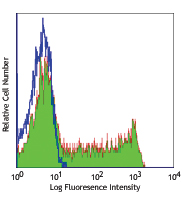
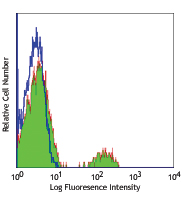
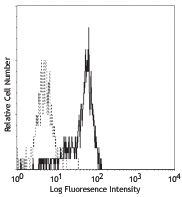
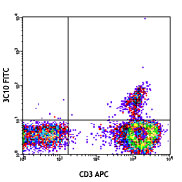
 Login / Register
Login / Register 








Follow Us